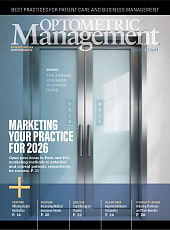MYOPIA CONTINUES TO increase globally, prompting an increased focus on innovative strategies for managing it. Specialty lenses, including orthokeratology (ortho-k) and soft multifocals, remain at the forefront of optical interventions. As research evolves, new approaches, including combination therapies and emerging technologies, may shape the future of myopia management.
Advances in Lens Design
The effectiveness of ortho-k and multifocal soft lenses in slowing myopia progression is well established (Wildsoet et al, 2019). Innovations in soft lens technology have yielded multiple design options available to practitioners, including concentric, zonal aspheric, and extended depth of focus (EDOF). Today’s ortho-k designs accommodate more patients than ever, with toric options available and the ability to customize parameters including the optic zone diameter.
Hybrid and scleral lens designs can also be employed for myopia management, potentially offering enhanced stability and comfort for some patients, including those who have corneal irregularities. Various spectacle lens designs for myopia management are in development, and several are being prescribed in markets outside the United States.
Combination Therapy
As the scientific consensus shifts toward the recommendation for higher concentrations of atropine for effective myopia control (Zhang et al, 2024), combination therapy with specialty lenses may boost effectiveness while managing the cycloplegic effect some children experience from atropine. Emerging research suggests that combining specialty contact lenses with atropine therapy may enhance myopia control effectiveness (Tsai et al, 2022), although more research is needed to understand how the addition of an optical intervention to atropine therapy affects aspects such as the rebound effect and the importance of atropine concentration.
Anecdotally, combination therapy does seem to be gaining traction as clinicians seek to optimize and individualize treatment plans for young myopes. As the evidence base continues to grow, the integration of atropine therapy with ortho-k or soft multifocals may become a standard recommendation for some patients in the future.
Future Directions
Research efforts are under way to develop biosensor-embedded lenses capable of monitoring characteristics such as intraocular pressure and tear film composition (Liu et al, 2024). Smart contact lenses may hold promise for the future of myopia management, although their widespread adoption remains a complex engineering challenge. Light-based therapies such as red light (RL) therapy may present an alternative to lens- or pharmaceutical-based myopia interventions. Although RL therapy has been shown to be effective for slowing myopia progression in China (Xu et al, 2024), concerns about prolonged exposure of the retinas of children to lasers limits its use at present.
Wavefront-guided lens customizations may open the door to enhanced outcomes by improving optical quality and enabling highly personalized peripheral focal profiles. Additionally, wearable devices that track visual habits—such as near-work duration and outdoor exposure—may be incorporated into clinical practice to optimize patient compliance and improve outcomes.
Considering advances in lens manufacturing capabilities, the integration of artificial intelligence and big data analytics may result in myopia management transitioning toward an even more personalized approach in the near future. Predictive algorithms based on biometric data may help refine treatment plans, allowing practitioners to tailor interventions to individual patients more effectively (Zhang and Zou, 2024).
References
1. Wildsoet CF, Chia A, Cho P, et al. IMI - interventions for controlling myopia onset and progression report. Invest Ophthalmol Vis Sci. 2019;60(3):M106-M131. doi: 10.1167/iovs.18-25958
2. Zhang XJ, Zhang Y, Yip BHK, et al. Five-year clinical trial of the low-concentration atropine for myopia progression (LAMP) study: phase 4 report. Ophthalmology. 2024;131(9):1011-1020. doi: 10.1016/j.ophtha.2024.03.013
3. Tsai HR, Wang JH, Huang HK, et al. Efficacy of atropine, orthokeratology, and combined atropine with orthokeratology for childhood myopia: A systematic review and network meta-analysis. J Formos Med Assoc. 2022 Dec;121(12):2490-2500. doi: 10.1016/j.jfma.2022.05.005
4. Liu X, Ye Y, Ge Y, et al. Smart contact lenses for healthcare monitoring and therapy. ACS Nano. 2024 Mar 5;18(9):6817-6844. doi: 10.1021/acsnano.3c12072
5. Xu Y, Cui L, Kong M, et al. Repeated low-level red light therapy for myopia control in high myopia children and adolescents: a randomized clinical trial. Ophthalmology. 2024 Nov;131(11):1314-1323. doi: 10.1016/j.ophtha.2024.05.023
6. Zhang J, Zou H. Insights into artificial intelligence in myopia management: from a data perspective. Graefes Arch Clin Exp Ophthalmol. 2024 Jan;262(1):3-17. doi: 10.1007/s00417-023-06101-5



